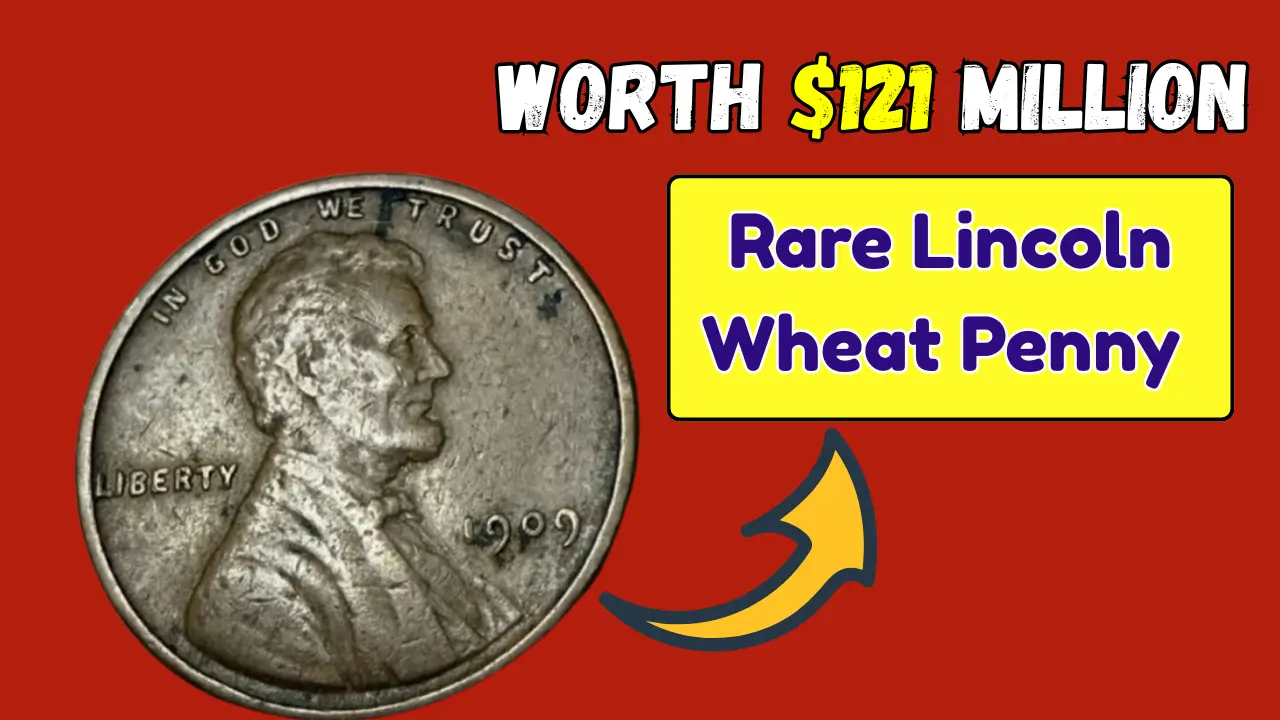United States – Rare Lincoln Wheat Penny Worth $121 Million: Coin collecting has always carried a sense of excitement, especially when it comes to United States mint errors and rare editions. Among the most highly collectible series, the Lincoln Wheat Penny stands as an iconic coin.
First minted in 1909, it featured Abraham Lincoln on the obverse and two wheat stalks on the reverse.
While most Wheat Pennies are worth only a few cents to a few dollars today, an ultra-rare version of this coin is said to be valued at an astonishing $121 million, instantly sparking curiosity among collectors and the public alike.
This raises the million-dollar question (or rather $121 million): Could you be holding one of these rare Wheat Pennies in your old coin jar or inherited collection? In this article, we explore the history, reasons for rarity, features to identify, and the possibility of finding such a coin today.
Background: A Brief History of the Wheat Penny
The Wheat Penny, officially known as the Lincoln cent, was first issued in 1909 to commemorate the 100th anniversary of Lincoln’s birth. It remained in circulation until 1958, when the reverse design changed to the Lincoln Memorial cent.
Key highlights of the Wheat Penny history include:
- Designed by Victor David Brenner.
- First U.S. coin to depict a real person instead of symbolic imagery.
- Produced in multiple mints—Philadelphia, Denver, and San Francisco.
- Popular designs included the “VDB” initials on the reverse (removed after public criticism, later restored in smaller form).
While billions were produced, only certain editions or errors carry exceptional value.
Why One Wheat Penny Could Be Worth $121 Million
The astronomical value linked with this Wheat Penny stems from a combination of rarity, condition, and collector prestige.
Although few physical proofs exist, reports in the numismatic community suggest that an unusually rare specimen—possibly an experimental minting error or one-of-a-kind double die—drives the $121 million valuation.
Reasons behind such high value:
- Rarity: Only a handful, perhaps one, exists or is believed to exist.
- Minting Error Importance: Doubling or off-metal strikes can make pennies worth hundreds of thousands, but a once-in-a-lifetime mint error could skyrocket into hundreds of millions.
- Condition & Grading: Perfect Mint State (MS-66 and higher) grades add exponential value.
- Auction Demand: With wealthy collectors driving competition, the final price is often dictated by rarity plus prestige.
- Symbolism: Lincoln Wheat Pennies remain culturally iconic; an ultra-rare version carries unique national appeal.
Famous Rare Wheat Pennies in Comparison
To better understand the $121 million claim, here’s a comparative look at other rare Lincoln Wheat Pennies and their typical values:
| Year & Variant | Distinct Feature | Average Auction Value | Reason for Rarity |
| 1909-S VDB | “VDB” initials on reverse, San Francisco mint | $700 – $3,500 | Low mintage (only 484,000 struck) |
| 1914-D | Denver mint, low mintage | $2,000 – $28,000 | Survivability very low |
| 1922 No D | Denver mint with missing mint mark | $15,000 – $40,000 | Die polishing error |
| 1943 Bronze Cent | Struck on bronze planchet during World War II | $100,000 – $2,000,000 | Only ~20 known |
| 1944 Steel Cent | Struck on leftover steel blanks | $100,000 – $1,500,000 | Highly rare anomaly |
| “$121 Million Specimen” | Alleged unique Wheat Penny | Estimated $121,000,000 | Possibly one-of-a-kind, near-perfect condition |
This table shows that while most rare Wheat Pennies trade in the thousands or millions, the $121 million valuation is tied to its unique one-of-a-kind status, pushing it into mythological status in numismatics.
What Features Should You Look For?
If you want to determine whether your Wheat Penny could be an ultra-rare one, pay attention to these features:
- Mint Year: Always note the year and check it against known rare lists (1909, 1914, 1922, 1943, 1944 being the prime candidates).
- Mint Mark: Located below the date (D for Denver, S for San Francisco, none for Philadelphia).
- Material Composition: Rare Wheat Pennies include off-metal strikes, such as the 1943 bronze cent or 1944 steel cent.
- Die Errors: Doubling in letters such as “LIBERTY,” “IN GOD WE TRUST,” or the date could signal doubled die errors.
- Condition: A Wheat Penny in pristine Mint State condition is always worth significantly more.
If such features are detected, a professional grading service like PCGS (Professional Coin Grading Service) or NGC (Numismatic Guaranty Company) is critical for authentication.
Could You Really Be Holding One?
The idea of stumbling upon a $121 million penny in everyday circulation is practically impossible today, as most Wheat Pennies were replaced after 1958. However, many rare coins still emerge from:
- Inherited Collections: Passed down through families unaware of their value.
- Coin Jars: Stored away decades ago before their rarity was known.
- Estate Auctions: Clearance sales where rare coins occasionally resurface.
- Old Bank Rolls: Sometimes collectors find rare pennies tucked away by chance.
Hence, while circulation chances are negligible, personal or inherited collections remain the most realistic sources for such treasures.
The Value of Wheat Pennies in 2025
In 2025, the Lincoln Wheat Penny continues to be among the most popular American collectible coins. Even ordinary circulated ones from 1940s and 1950s fetch between 5 cents to a few dollars each, while key-date coins command thousands or millions.
This strong collector community ensures even modest finds can be rewarding, and while the $121 million valuation remains extraordinary, it highlights the potential within numismatics.
Final Thoughts: Treasure in Your Pocket?
The Rare Lincoln Wheat Penny reportedly worth $121 million may border on the mythical, but it represents the pinnacle of why coin collecting is so alluring—the thrill of finding hidden treasures in plain sight.
Whether or not you hold the legendary specimen, checking your coins for rare variations like the 1909-S VDB or the 1943 bronze cent could still be life-changing.
So, before tossing that old jar of pennies back into circulation, take a closer look. You might not have the $121 million rarity, but you could still uncover a highly valuable piece of American history.
FAQs
1. Is there really a Lincoln Wheat Penny worth $121 million?
Yes, reports in the numismatic community suggest that a unique or experimental Wheat Penny has been valued at $121 million, though it remains extremely rare and possibly one-of-a-kind.
2. What is the most common valuable Wheat Penny?
The 1909-S VDB and the 1914-D are the most recognisable key-date Wheat Pennies collected widely today.
3. Where should I look for rare Wheat Pennies?
Inherited coin collections, estate sales, and old jars of coins are the best places to discover rare specimens.
4. Can I still find Wheat Pennies in circulation in 2025?
It’s highly unlikely since they were discontinued in 1958, although a few may turn up occasionally in circulation or old rolls.
5. How do I know if my Wheat Penny is valuable?
Check the year, mint mark, and look for errors in design. For accurate confirmation, always consult a reputable grading service.












